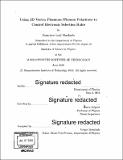Using 2D vortex plasmons/phonon polaritons to control electronic selection rules
Author(s)
Leal Machado, Francisco
DownloadFull printable version (5.640Mb)
Alternative title
Using 2-dimensional plasmons/phonon polaritons to control electronic selection rules
Using two-dimensional vortex plasmons/phonon polaritons to control electronic selection rules
Other Contributors
Massachusetts Institute of Technology. Department of Physics.
Advisor
Marin Soljač̌ić́.
Terms of use
Metadata
Show full item recordAbstract
The discovery of orbital angular momentum (OAM) sustaining modes established a new degree of freedom by which to control not only the flow of light but also its interaction with matter. However, OAM sustaining modes have yet to be used to control the quantum dynamics of an electron in an atom or molecule due to the large length scale discrepancy between the wavelength of light and the size of the electron's orbital. In this work, we analyze the interaction between OAM carrying polariton vortex modes (for plasmon and phonon polaritons) and a hydrogen atom, and show that these modes can be used to engineer new selection rules in electronic transitions. Moreover, we show that these selection rules are robust to the displacement of the electronic system away from the vortex center. Perhaps more surprisingly, we find how displacement can be used favourably to tune which absorption process is dominant. Our findings are best suited to vortex modes that can be created in graphene, monolayer conductors, hBN, thin polar dielectrics, and many other polariton-sustaining thin materials. Another platform for observing these effects could be quantum dots interfaced with surface plasmons in-conventional metals.
Description
Thesis: S.B., Massachusetts Institute of Technology, Department of Physics, 2016. Cataloged from PDF version of thesis. Includes bibliographical references (pages 69-73).
Date issued
2016Department
Massachusetts Institute of Technology. Department of PhysicsPublisher
Massachusetts Institute of Technology
Keywords
Physics.